#12th cent. medieval castle
Photo

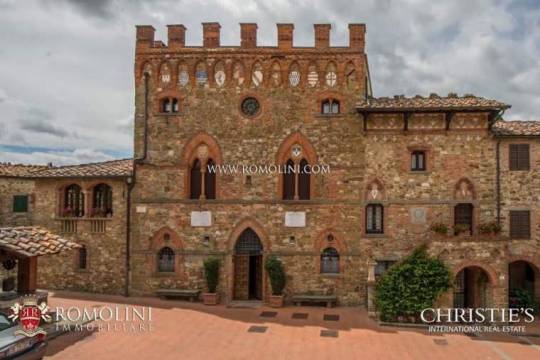
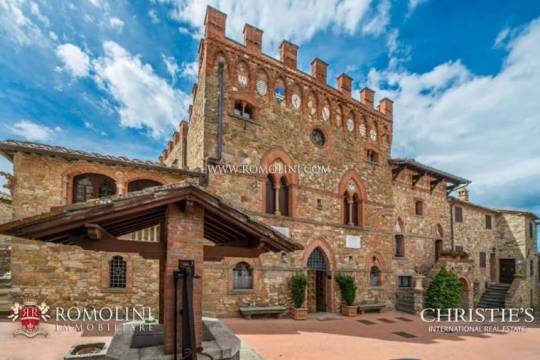
This is real 12th cen. castle in Tuscany, Italy. That it even exists and is beautifully preserved is amazing. It was restored for the first time in 1907 and if you want to know the price, you have to ask, b/c it’s probably outrageous.



The castle (800 sqm) (8,611 sqft) is located in the center of the medieval hamlet, and constitutes one of the four sides of the main square. On the inside (and a small annex) 9 luxury mini-apartments with just as many double (or twin) bedrooms with en suite bathrooms.

How crazy is this? Frescos & carved stone walls perfectly preserved.


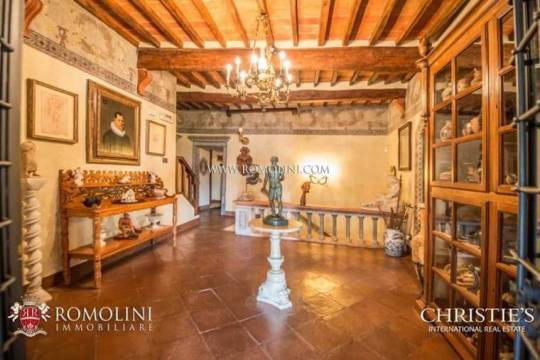
And, of course they had to electrify it, put in plumbing, etc. The property is then completed by three independent apartments located in the surrounding hamlet, a gym with dressing room, a garage and some storage rooms.
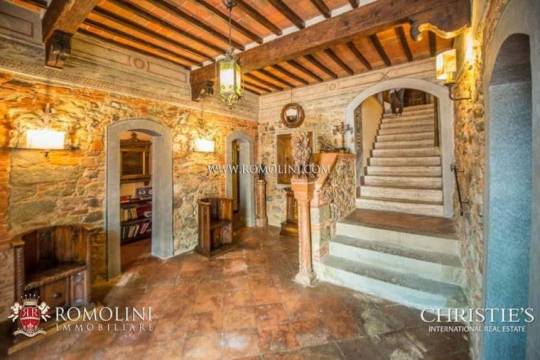
The interior remains magnificent with lots of the original structure.


Even though it’s split into apts., it still looks like a medieval castle.
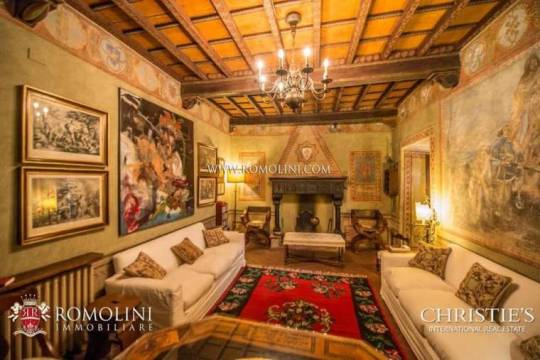

Original fireplaces and lots of those wonderful frescos.

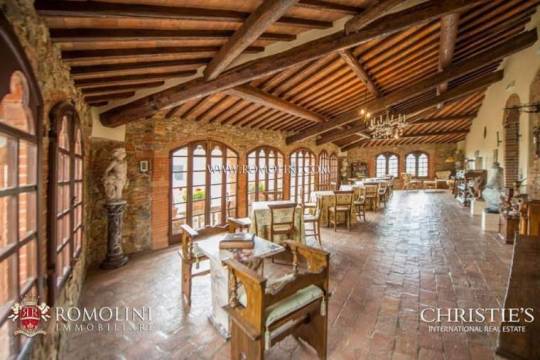
Look at this dining hall.

That carved lion.
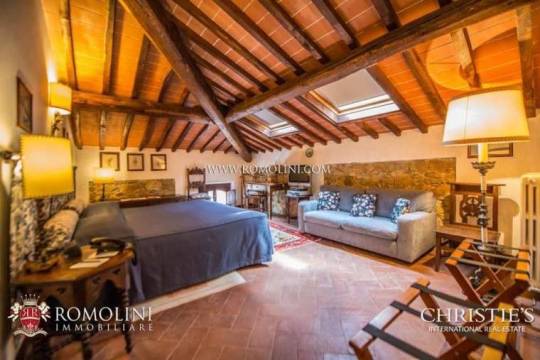
Then, it starts to get modern at this point in a guest area.

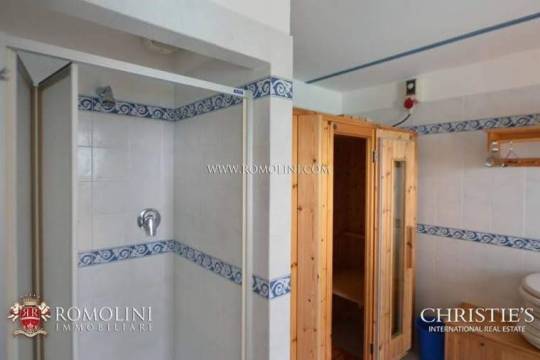
And, it goes full-on cheap tile shower, sauna and elevated toilet.

The first trace of a hamlet, though, dates back to the Langobardic era, just after the fall of the Ostrogothic Kingdom in 553 AD. The medieval castle itself was probably built in the 12th century and in 1385 it was gifted by the owners to the First Florentine Republic (1115-1434 AD) which used it as a defensive fortress in its long war against Siena.
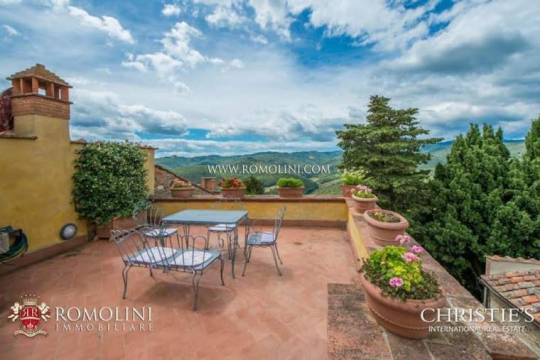
Its position exposed the castle to numerous attacks and pillages. Uh-oh, it wasn’t in the best location- can you imagine being up here, watching attackers and pillagers storm the castle?
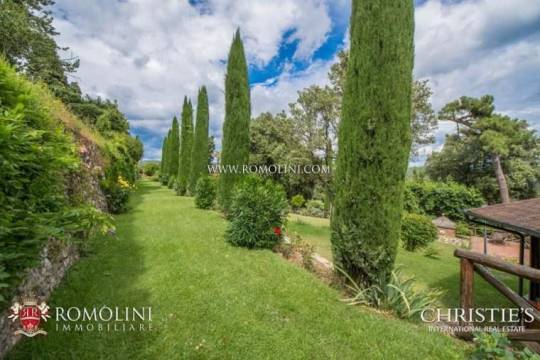
The gardens are stunning. But, the worst episode took place in 1528 and the castle suffered heavy damage. Between the 16th and 17th century the castle was rebuilt and the hamlet developed to the extent it is today.
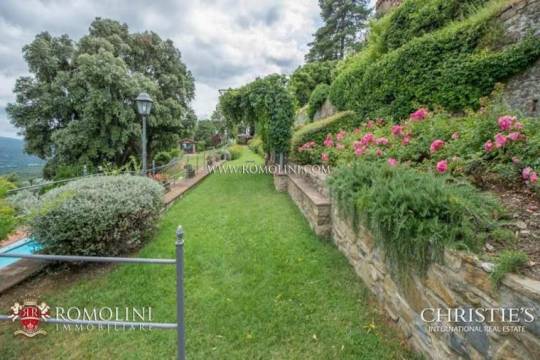

In 1907 the castle was restored, but the architect who worked on the building modified the complex adding several anti-historical traits. The last restoration, which led to the conversion of the building into a luxury hosting activity, took place in 1997.


Here’s a little guest facility that’s very modern. All-in-all, it’s a good restoration.
https://www.captivatinghouses.com/2020/07/23/12th-century-italian-castle-for-sale-in-tuscany-italy/
#12th cent. medieval castle#ancient tuscan castle#long post#medieval castle restoration#architecture
208 notes
·
View notes
Link
The capital of Poitour-Charentes to the west of France, Poitiers is a university city with upper-class medieval history to go into.
All you need is a bit of a foundation and many churches have profound meanings as queens, dukes, and rulers from this city come alive. There are countless lovely half-framed houses on squares like Place Charles de Gaulle, and you can have fun hunting down gothic and revival palaces, where Marsh City often lives. And then you can leave the past behind, at least for a few hours, at the amusement park Futramodern Ultramodern. Discover the best things to do in Poitiers.
[toc]
1. Musée Sainte-Croix
The largest museum in the city is housed in a brutal labyrinth building since the 1970s. After an intensive quest through these galleries, divided into prehistoric, archeology, medieval history, fine art and regional ethnography, you'll find quite interesting about Poitiers and the area. field.
You may be convinced by the archeology department because the museum was built on the 7th-century Ste-Croix Monastery.
2. Futuroscope
Because the Lumière brothers in 19th-century France were at the forefront of film art and the Futurcop theme park stems from that heritage.
It is France’s third most popular theme park and has been dazzling visitors for more than 30 years with simulators, rides and breathtaking presentations in IMAX 3D and 4D theatres.
The venue for the trips and shows is phenomenal metal and glass structures, some rounded and others rounded, but all of them are vast in size. Most programs have set start time, so as opposed to most theme parks, you can plan ahead and not waste your day in the queue.
3. Baptistère Saint-Jean
In Poitiers, you can enter the oldest Christian church in France, built in the 4th century and then changed in the 7th century to the present form.
In the Merovingian period, they made a mess when it came to baptism, and instead of the small font, the church contained a large octagonal tank, in which everyone needed to completely immerse themselves to complete the admission ceremony.
4. Église Saint-Hilaire Le Grand
Because of its location on the Way of St. James pilgrimage route, this hushed romanesque church is a UNESCO World Heritage Site. The Revolution wasn’t kind to the building, and the nave was torn down and had to be rebuilt.
But in the choir and ambulance, there is a lot of splendid medieval art. Four chapels have frescoes from the 1000s, among them one of the first medieval representations of the apocalypse.
Lying down in the catacombs, a 17th-century chest holds the relics of St. Hilary, Bishop Poitiers in the 4th century and is the leading writer and theologian of the era.
5. Parc de Blossac
By the middle of the 18th century, Count Blossac had a big plan for Poitiers to shake off the medieval image with this expansive avenue and open space like this lavish park. The park is actually skirted by some of the old city walls, as you can see in the southern corner.
From there, you can also follow the Chemin de la Cagouillere walk to the right bank of the Clain River. Most of the parks are French-style parterres, with straight-arrow boulevards next to the terrain.
There is also a romantic English garden with flower gardens, a decorative river, statues, caves and some menagerie with guinea pigs, macaws, and rabbits.
6. Église Notre-Dame la Grande
Inside are medieval paintings above the choir, showing Christ in majesty and the Virgin and Child surrounded by a mandorla. But it’s the church’s portal that wins most acclaim, with sophisticated 12th-century friezes showing images from passages in the old and new testaments.
7. Grande Salle – Palais de Poitiers
There, only one room is visible in the courts of Poitiers, formerly the headquarters of Duke Aquitaine and Earl Poitou, and you have to be brave to check the bag airlines to enter. But if you’re curious about English and French history this is a small price to pay.
Because the Grand Salle is a dining room ordered in the 1190s by Eleanor of Aquitaine, one of the most powerful women in medieval Europe. At 50 meters by 17, it may well have been the largest in Europe at the time.
There are three giant fireplaces, magical traces on the windows and sculptures of figures in the court of Poitiers, like John of Berry and Isabeau of Bavaria.
8. Poitiers Cathedral
Eleanor also commissioned the city's large church in 1162 and it was completed about a century later, quite quickly for a building of this size in the middle ages. If you fall in love with medieval history, you might have a field day here.
First, almost all of the stained-glass windows in the choir and transept are original, and if you're an eagle eye, you'll recognize Eleanor and Henry II in one. The wooden choir stalls are some of the oldest in France, carved in the gothic Paris style in the mid-13th century.
Originally there would have been 100, but even with the 74 remainings, you’re left in no doubt about the high status of the cathedral chapter in these times.
9. Hôtel Fumé
The Rue de la Chaîne is one of the most interesting streets in the city, crowded with medieval houses with cross patterns on wooden frames and iron gas lamps suspended in the middle of the road.
Follow it up the hill and it transforms into Rue René Descartes, on which you will be surprised at the majestic facade of Hôtel Fumé. This is a gaudy gothic castle built in the 15th and 16th centuries by the mayor of the city and is currently the university's humanities department.
Walkthrough the walkway into the courtyard, where the sculpted, twisted columns support a semi-wooden showroom with crushed windows.
10. Place du Maréchal-Leclerc
The main square in Poitier Cente-Ville walkway has a completely different feeling from the narrow medieval city streets but very lovely because of the feeling of space and airy. Place du Maréchal-Leclerc is enclosed by Belle Époque and art deco buildings.
Note the facade of Société Générale, which dates back to 1928 and the old city theater built-in 1954 in the style of artistic renaissance.
The City Hall is a bit older, dating to the mid-1800s during the Second Empire, and it hosts occasional open weekends when you can go in to poke around the salons and grand staircase.
Over the past few years, stylish modern benches have been added to the plaza, and there are cafes around if you need a break to visit.
More ideals for you: Top 10 things to do in Poissy
From : https://wikitopx.com/travel/top-10-things-to-do-in-poitiers-709472.html
0 notes
Text
Where To Go In April 2018: Amazing Events & Holiday Destinations In The UK
With the ‘Beast from the East’ behind us and spring in the air, it’s time to blow the cobwebs away and get out and about. The UK is brimming with things to do in April, from foodie festivals to literary events. And with the Easter holidays approaching, why not book a break away so the whole family can join in with the fun?
Where To Stay For Amazing April Events
For the best April events, you’ll be spoilt for choice when it comes to finding a place to stay. Holiday Lettings has hundreds of rentals all over the UK, whether you’re looking for a city centre apartment in Manchester or a converted barn in the Cotswolds. If you’ve been wondering where to go in April, let these fantastic festivals be your guide and combine your visit with a holiday.
Northern Vegan Festival | Manchester
When: 7 April
In 2018, the Northern Vegan Festival and its partner, the Great Yorkshire Vegan Festival, was voted the UK’s second favourite vegan festival. It’s easy to see why, as this healthy food extravaganza hosts 200 stalls, cookery demonstrations, inspirational talks, interactive workshops and yoga. There’ll also be children’s activities throughout the day. Entry is £5 and 100 per cent of the ticket money goes to animal welfare charities as the festival is completely run by volunteers. There’s so much to do in Manchester, why not make a holiday of it and book a stay nearby?
See all rentals in Manchester
Skipton Beer Festival | Skipton
When: 12 – 14 April
The 12th Skipton Beer Festival will once again be at Ermysted’s Grammar School and it’s shaping up to be a fantastic event. The festival will be showcasing over 75 real ales from Orkney to Somerset, ciders and perries from Cornwall to Scotland and bottled beers from around the world. After sampling the drinks, you might get a bit peckish but don’t worry – food at all sessions will be provided by local butchers, Drake and Macefield. If wine is your tipple of choice, there’ll be some fruity numbers available, and soft drinks will be on offer for the designated drivers. And as the festival is just a 12-minute walk from the town centre, you can explore the independent shops and historic sights, such as Skipton Castle, while you’re there.
Go beer sampling when you book a stay in Skipton
Surrey Food Festival | Richmond-Upon-Thames
When: 21 April
The Surrey Food Festival returns for its third year in 2018 with over 100 different food stalls showcasing their products. Expect fantastic marketplace traders and a Kids Zone full of entertainment for the children to enjoy. There’ll be a number of acts performing on the main stage throughout the day, with bars offering a range of drinks from champagne to speciality ale. If you love food and drink, make Richmond-Upon-Thames your number one stop this April. There are plenty of rentals to choose from nearby, whether you’re looking for a romantic cottage for two or a spacious family home.
Book a stay in Richmond-Upon-Thames this April for a fantastic foodie-fest
The Bishop Auckland Food Festival | County Durham
When: 21 – 22 April
The Bishop Auckland Food Festival is a fabulous free event for all the family held in the heart of the town centre. Watch live demos from celebrity chefs, including This Morning’s Phil Vickery and Great British Bake Off winner Candice Brown, in the Town Hall for just £5 each. Enrol in The Gin School or the Chocolate Workshops, and gain some expert cooking advice on the Market Place live stage. With 120 specialist food and drink producers, pop-up cafes, workshops for both the adults and children, and live music, this event is not to be missed!
Choose your favourite rental in County Durham
ChipLitFest | Chipping Norton
When: 26 – 29 April
Chipping Norton Literary Festival is a celebration of all things bookish in the heart of this beautiful Cotswold town. You’ll have the chance to meet well-known and new writers, from Lionel Shriver, the author of We Need to Talk About Kevin, to second-time novelist Kit de Waal (pictured). Media stars including Jeremy Vine, Liza Tarbuck, Reggie Yates and Richard Osman will also be joining in with the festival. There’s a wide range of events covering fiction, food, nature and health, along with poetry and writers’ workshops. And, as ever, there’s a fun-packed children’s programme across the weekend.
Book a book-lovers break in Chipping Norton this April
The Llandeilo Lit Fest | Llandeilo
When: 26 – 29 April
This four-day festival includes Welsh, English and bilingual literary events such as discussions between leading academics, Welsh Rugby Union stars and entrepreneurs. There’ll also be comedy from stand-up Noel James, and panel discussions. Literature and music blend in the Medieval Music event, whilst comedy and history combine in Psychopaths in Literature. Plus, readings for children will keep younger book fans entertained, and workshops for writers will help budding authors hone their skills. The packed programme is sure to leave you feeling inspired and with a reading list to last you through the summer and beyond!
Look for a literary stay in Llandeilo
Hexham Book Festival | Hexham
When: 26 April – 6 May
The annual literary festival takes over this Northumberland town every spring and it’s not afraid of tackling the big issues. The festival features heavy-hitting discussions about politics, with guests including Harriet Harman, Alastair Campbell, Evan Davis, John Crace and Chris Mullin. There’ll be discussions on philosophy with AC Grayling, and on fiction with Kate Mosse and Rachel Joyce, among others. Jeremy Vine and Tim Marshall will be covering topical issues and there’ll be cookery demonstrations by leading food writers, writing workshops, book signings and much more. If you’re looking for things to do in April, Hexham also has guided tours and a two-day book fair in the Civic Hall during the festival.
Book your holiday in Hexham
TradFest Edinburgh | Edinburgh
When: 26 April – 6 May
Calling all culture-vultures! Celebrate Scotland’s rich past and traditions while revelling in the best of the country’s contemporary performers, with story, music, song, film and dance. Residents and visitors alike will be joining in the fun and there’s something for everyone, without breaking the bank! Performers, both local and international, take part in more than 80 shows and events across 27 venues. So, book a break in Edinburgh this April to join in with the convivial ceilidh and experience the heart of a nation inspired by tradition.
Celebrate Scotland with a stay in Edinburgh
The East Anglian Game & Country Fair | Euston, Thetford
When: 28 – 29 April
This pet-friendly show includes events and attractions from across the globe. Come and have a go at country pursuits guided by experts or compete in various competitions running over the two days. Browse over 350 shopping stands, food halls and craft halls, and watch cookery demonstrations by top chefs from the region. Sit back and relax in our VIP suite overlooking the Main Arena situated in front of Euston Hall whilst sipping a Pimm’s. Or indulge in afternoon tea in the beautiful grounds of Euston Estate, by kind permission of the Duke and Duchess of Grafton. When it comes to April events, this country show is definitely a contender.
Book a rental in Thetford this April
Beltane Fire Festival | Edinburgh
When: 30 April
This exciting celebration of summer is a dazzling display of fire, drumming, and acrobatics on a scale not seen anywhere else in the world. The event marks the changing seasons by bringing this ancient Celtic festival to a modern audience. For one special night, a huge cast of otherworldly creatures lead thousands of spectators on an unforgettable procession around Calton Hill. Through spectacular fiery displays and immersive storytelling, the event shows the May Queen transforming the Green Man from his wintry guise so they can rule together over the warmer months. If you’re looking for things to do in April with a difference, you’ll love the Beltane Fire Festival.
Choose a break in Edinburgh
The post Where To Go In April 2018: Amazing Events & Holiday Destinations In The UK appeared first on Holiday Lettings Blog.
from News And Tips For Traveling https://blog.holidaylettings.co.uk/april-events-holiday-destinations-uk/
0 notes
Text
Colosseum
Location–Regio IV Templum Pacis (“Temple of Peace”). Built in–70-80.A.D. Type of Structure–Amphitheatre. Built by/for-Vespasian, Titus.
The Colosseum or Coliseum (/kɒləˈsiːəm/ kol-ə-see-əm), also known as the Flavian Amphitheatre (Latin: Amphitheatrum Flavium; Italian: Anfiteatro Flavio [aŋfiteˈaːtro ˈflaːvjo] or Colosseo [kolosˈsɛːo]), is an oval amphitheatre in the centre of the city of Rome, Italy. Built of concrete and sand, it is the largest amphitheatre ever built. The Colosseum is situated just east of the Roman Forum. Construction began under the emperor Vespasian in AD 72, and was completed in AD 80 under his successor and heir Titus. Further modifications were made during the reign of Domitian (81–96). These three emperors are known as the Flavian dynasty, and the amphitheatre was named in Latin for its association with their family name (Flavius).
The Colosseum could hold, it is estimated, between 50,000 and 80,000 spectators, having an average audience of some 65,000; it was used for gladiatorial contests and public spectacles such as mock sea battles (for only a short time as the hypogeum was soon filled in with mechanisms to support the other activities), animal hunts, executions, re-enactments of famous battles, and dramas based on Classical mythology. The building ceased to be used for entertainment in the early medieval era. It was later reused for such purposes as housing, workshops, quarters for a religious order, a fortress, a quarry, and a Christian shrine.
Although partially ruined because of damage caused by earthquakes and stone-robbers, the Colosseum is still an iconic symbol of Imperial Rome. It is one of Rome’s most popular tourist attractions and also has links to the Roman Catholic Church, as each Good Friday the Pope leads a torchlit “Way of the Cross” procession that starts in the area around the Colosseum.
The Colosseum is also depicted on the Italian version of the five-cent euro coin.
#gallery-0-36 { margin: auto; } #gallery-0-36 .gallery-item { float: left; margin-top: 10px; text-align: center; width: 50%; } #gallery-0-36 img { border: 2px solid #cfcfcf; } #gallery-0-36 .gallery-caption { margin-left: 0; } /* see gallery_shortcode() in wp-includes/media.php */
Map the Colosseum in Rome, Italy.
The Colosseum
The Colosseum’s original Latin name was Amphitheatrum Flavium, often anglicized as Flavian Amphitheatre. The building was constructed by emperors of the Flavian dynasty, following the reign of Nero. This name is still used in modern English, but generally the structure is better known as the Colosseum. In antiquity, Romans may have referred to the Colosseum by the unofficial name Amphitheatrum Caesareum (with Caesareum an adjective pertaining to the title Caesar), but this name may have been strictly poetic as it was not exclusive to the Colosseum; Vespasian and Titus, builders of the Colosseum, also constructed an amphitheater of the same name in Puteoli (modern Pozzuoli).
The name Colosseum has long been believed to be derived from a colossal statue of Nero nearby (the statue of Nero was named after the Colossus of Rhodes). This statue was later remodeled by Nero‘s successors into the likeness of Helios (Sol) or Apollo, the sun god, by adding the appropriate solar crown. Nero’s head was also replaced several times with the heads of succeeding emperors. Despite its pagan links, the statue remained standing well into the medieval era and was credited with magical powers. It came to be seen as an iconic symbol of the permanence of Rome.
In the 8th century, a famous epigram attributed to the Venerable Bede celebrated the symbolic significance of the statue in a prophecy that is variously quoted: Quamdiu stat Colisæus, stat et Roma; quando cadet colisæus, cadet et Roma; quando cadet Roma, cadet et mundus (“as long as the Colossus stands, so shall Rome; when the Colossus falls, Rome shall fall; when Rome falls, so falls the world”). This is often mistranslated to refer to the Colosseum rather than the Colossus (as in, for instance, Byron‘s poem Childe Harold’s Pilgrimage). However, at the time that the Pseudo-Bede wrote, the masculine noun coliseus was applied to the statue rather than to what was still known as the Flavian amphitheatre.
The Colossus did eventually fall, possibly being pulled down to reuse its bronze. By the year 1000 the name “Colosseum” had been coined to refer to the amphitheatre. The statue itself was largely forgotten and only its base survives, situated between the Colosseum and the nearby Temple of Venus and Roma.
The name further evolved to Coliseum during the Middle Ages. In Italy, the amphitheatre is still known as il Colosseo, and other Romance languages have come to use similar forms such as Coloseumul (Romanian), le Colisée (French), el Coliseo (Spanish) and o Coliseu (Portuguese).
History
Construction, inauguration and the Roman renovations
The site chosen was a flat area on the floor of a low valley between the Caelian, Esquiline and Palatine Hills, through which a canalised stream ran. By the 2nd century BC the area was densely inhabited. It was devastated by the Great Fire of Rome in AD 64, following which Nero seized much of the area to add to his personal domain. He built the grandiose Domus Aurea on the site, in front of which he created an artificial lake surrounded by pavilions, gardens and porticoes. The existing Aqua Claudia aqueduct was extended to supply water to the area and the gigantic bronze Colossus of Nero was set up nearby at the entrance to the Domus Aurea.
The Colosseum
Although the Colossus was preserved, much of the Domus Aurea was torn down. The lake was filled in and the land reused as the location for the new Flavian Amphitheatre. Gladiatorial schools and other support buildings were constructed nearby within the former grounds of the Domus Aurea. Vespasian’s decision to build the Colosseum on the site of Nero’s lake can be seen as a populist gesture of returning to the people an area of the city which Nero had appropriated for his own use. In contrast to many other amphitheatres, which were located on the outskirts of a city, the Colosseum was constructed in the city centre; in effect, placing it both symbolically and precisely at the heart of Rome.
Sestertius of Titus celebrating the inauguration of the Colosseum (minted 80.A.D.)
Construction was funded by the opulent spoils taken from the Jewish Temple after the Great Jewish Revolt in 70 AD led to the Siege of Jerusalem. According to a reconstructed inscription found on the site, “the emperor Vespasian ordered this new amphitheatre to be erected from his general’s share of the booty.” Along with the spoils, estimated 100,000 Jewish prisoners were brought back to Rome after the war, and many contributed to the massive workforce needed for construction. The slaves undertook manual labor such as working in the quarries at Tivoli where the travertine was quarried, along with lifting and transporting the quarried stones 20 miles from Tivoli to Rome. Along with this free source of unskilled labor, teams of professional Roman builders, engineers, artists, painters and decorators undertook the more specialized tasks necessary for building the Colosseum.
Cross-Section from the Lexikon der gesamten technik (1904)
Construction of the Colosseum began under the rule of Vespasian in around 70–72 AD (73-75 AD according to some sources) The Colosseum had been completed up to the third story by the time of Vespasian’s death in 79. The top level was finished by his son, Titus, in 80, and the inaugural games were held in A.D. 80 or 81. Dio Cassius recounts that over 9,000 wild animals were killed during the inaugural games of the amphitheatre. Commemorative coinage was issued celebrating the inauguration. The building was remodelled further under Vespasian’s younger son, the newly designated Emperor Domitian, who constructed the hypogeum, a series of underground tunnels used to house animals and slaves. He also added a gallery to the top of the Colosseum to increase its seating capacity.
A map of Central Rome during the Roman Empire, with the Colosseum at the upper right corner.
In 217, the Colosseum was badly damaged by a major fire (caused by lightning, according to Dio Cassius) which destroyed the wooden upper levels of the amphitheatre’s interior. It was not fully repaired until about 240 and underwent further repairs in 250 or 252 and again in 320. Gladiatorial fights are last mentioned around 435. An inscription records the restoration of various parts of the Colosseum under Theodosius II and Valentinian III (reigned 425–455), possibly to repair damage caused by a major earthquake in 443; more work followed in 484 and 508. The arena continued to be used for contests well into the 6th century. Animal hunts continued until at least 523, when Anicius Maximus celebrated his consulship with some venationes, criticised by King Theodoric the Great for their high cost.
Medieval
The Colosseum underwent several radical changes of use during the medieval period. By the late 6th century a small chapel had been built into the structure of the amphitheater, though this apparently did not confer any particular religious significance on the building as a whole. The arena was converted into a cemetery. The numerous vaulted spaces in the arcades under the seating were converted into housing and workshops, and are recorded as still being rented out as late as the 12th century. Around 1200 the Frangipani family took over the Colosseum and fortified it, apparently using it as a castle.
Map of Medieval Rome depicting the Colosseum
Severe damage was inflicted on the Colosseum by the great earthquake in 1349, causing the outer south side, lying on a less stable alluvial terrain, to collapse. Much of the tumbled stone was reused to build palaces, churches, hospitals and other buildings elsewhere in Rome. A religious order moved into the northern third of the Colosseum in the mid-14th century and continued to inhabit it until as late as the early 19th century. The interior of the amphitheater was extensively stripped of stone, which was reused elsewhere, or (in the case of the marble façade) was burned to make quicklime. The bronze clamps which held the stonework together were pried or hacked out of the walls, leaving numerous pockmarks which still scar the building today.
Modern
During the 16th and 17th century, Church officials sought a productive role for the Colosseum. Pope Sixtus V (1585–1590) planned to turn the building into a wool factory to provide employment for Rome’s prostitutes, though this proposal fell through with his premature death. In 1671 Cardinal Altieri authorized its use for bullfights; a public outcry caused the idea to be hastily abandoned.
In 1749, Pope Benedict XIV endorsed the view that the Colosseum was a sacred site where early Christians had been martyred. He forbade the use of the Colosseum as a quarry and consecrated the building to the Passion of Christ and installed Stations of the Cross, declaring it sanctified by the blood of the Christian martyrs who perished there (see Significance in Christianity). However, there is no historical evidence to support Benedict’s claim, nor is there even any evidence that anyone prior to the 16th century suggested this might be the case; the Catholic Encyclopedia concludes that there are no historical grounds for the supposition, other than the reasonably plausible conjecture that some of the many martyrs may well have been.
#gallery-0-37 { margin: auto; } #gallery-0-37 .gallery-item { float: left; margin-top: 10px; text-align: center; width: 50%; } #gallery-0-37 img { border: 2px solid #cfcfcf; } #gallery-0-37 .gallery-caption { margin-left: 0; } /* see gallery_shortcode() in wp-includes/media.php */
The Colosseum in a 1757 engraving by Giovanni Battista Piranesi
Allied troops consult a guidebook outside the Colosseum after liberation in 1944
Later popes initiated various stabilization and restoration projects, removing the extensive vegetation which had overgrown the structure and threatened to damage it further. The façade was reinforced with triangular brick wedges in 1807 and 1827, and the interior was repaired in 1831, 1846 and in the 1930s. The arena substructure was partly excavated in 1810–1814 and 1874 and was fully exposed under Benito Mussolini in the 1930s.
The Colosseum is today one of Rome’s most popular tourist attractions, receiving millions of visitors annually. The effects of pollution and general deterioration over time prompted a major restoration programme carried out between 1993 and 2000, at a cost of 40 billion Italian lire ($19.3m / €20.6m at 2000 prices).
1747 view by Giovanni Paolo Panini, emphasizing the semi-rural environs of the Colosseum at the time
In recent years the Colosseum has become a symbol of the international campaign against capital punishment, which was abolished in Italy in 1948. Several anti–death penalty demonstrations took place in front of the Colosseum in 2000. Since that time, as a gesture against the death penalty, the local authorities of Rome change the color of the Colosseum’s night time illumination from white to gold whenever a person condemned to the death penalty anywhere in the world gets their sentence commuted or is released, or if a jurisdiction abolishes the death penalty. Most recently, the Colosseum was illuminated in gold in November 2012 following the abolishment of capital punishment in the American state of Connecticut in April 2012.
Interior of the Colosseum, Rome (1832) by Thomas Cole, showing the Stations of the Cross around the arena and the extensive vegetation
Because of the ruined state of the interior, it is impractical to use the Colosseum to host large events; only a few hundred spectators can be accommodated in temporary seating. However, much larger concerts have been held just outside, using the Colosseum as a backdrop. Performers who have played at the Colosseum in recent years have included Ray Charles (May 2002), Paul McCartney (May 2003), Elton John (September 2005), and Billy Joel (July 2006).
Physical Description
Exterior
Unlike earlier Greek theatres that were built into hillsides, the Colosseum is an entirely free-standing structure. It derives its basic exterior and interior architecture from that of two Roman theatres back to back. It is elliptical in plan and is 189 meters (615 ft / 640 Roman feet) long, and 156 meters (510 ft / 528 Roman feet) wide, with a base area of 24,000 square metres (6 acres). The height of the outer wall is 48 meters (157 ft / 165 Roman feet). The perimeter originally measured 545 meters (1,788 ft / 1,835 Roman feet). The central arena is an oval 87 m (287 ft) long and 55 m (180 ft) wide, surrounded by a wall 5 m (15 ft) high, above which rose tiers of seating.
#gallery-0-38 { margin: auto; } #gallery-0-38 .gallery-item { float: left; margin-top: 10px; text-align: center; width: 50%; } #gallery-0-38 img { border: 2px solid #cfcfcf; } #gallery-0-38 .gallery-caption { margin-left: 0; } /* see gallery_shortcode() in wp-includes/media.php */
The Colosseum today as a background to the busy metropolis
The exterior of the Colosseum, showing the partially intact outer wall (left) and the mostly intact inner wall (center and right)
The outer wall is estimated to have required over 100,000 cubic metres (3,531,467 cubic feet) of travertine stone which were set without mortar; they were held together by 300 tons of iron clamps. However, it has suffered extensive damage over the centuries, with large segments having collapsed following earthquakes. The north side of the perimeter wall is still standing; the distinctive triangular brick wedges at each end are modern additions, having been constructed in the early 19th century to shore up the wall. The remainder of the present-day exterior of the Colosseum is in fact the original interior wall.
The surviving part of the outer wall’s monumental façade comprises three stories of superimposedarcades surmounted by a podium on which stands a tall attic, both of which are pierced by windows interspersed at regular intervals. The arcades are framed by half-columns of the Doric, Ionic, and Corinthian orders, while the attic is decorated with Corinthian pilasters. Each of the arches in the second- and third-floor arcades framed statues, probably honoring divinities and other figures from Classical mythology.
Two hundred and forty mast corbels were positioned around the top of the attic. They originally supported a retractable awning, known as the velarium, that kept the sun and rain off spectators. This consisted of a canvas-covered, net-like structure made of ropes, with a hole in the center It covered two-thirds of the arena, and sloped down towards the center to catch the wind and provide a breeze for the audience. Sailors, specially enlisted from the Roman naval headquarters at Misenum and housed in the nearby Castra Misenatium, were used to work the velarium.
#gallery-0-39 { margin: auto; } #gallery-0-39 .gallery-item { float: left; margin-top: 10px; text-align: center; width: 50%; } #gallery-0-39 img { border: 2px solid #cfcfcf; } #gallery-0-39 .gallery-caption { margin-left: 0; } /* see gallery_shortcode() in wp-includes/media.php */
Entrance LII of the Colosseum, with Roman numerals still visible
Original façade of the Colosseum
The Colosseum’s huge crowd capacity made it essential that the venue could be filled or evacuated quickly. Its architects adopted solutions very similar to those used in modern stadiums to deal with the same problem. The amphitheatre was ringed by eighty entrances at ground level, 76 of which were used by ordinary spectators. Each entrance and exit was numbered, as was each staircase. The northern main entrance was reserved for the Roman Emperor and his aides, whilst the other three axial entrances were most likely used by the elite. All four axial entrances were richly decorated with painted stucco reliefs, of which fragments survive. Many of the original outer entrances have disappeared with the collapse of the perimeter wall, but entrances XXIII (23) to LIV (54) survive.
Spectators were given tickets in the form of numbered pottery shards, which directed them to the appropriate section and row. They accessed their seats via vomitoria (singular vomitorium), passageways that opened into a tier of seats from below or behind. These quickly dispersed people into their seats and, upon conclusion of the event or in an emergency evacuation, could permit their exit within only a few minutes. The name vomitoria derived from the Latin word for a rapid discharge, from which English derives the word vomit.
Interior seating
According to the Codex-Calendar of 354, the Colosseum could accommodate 87,000 people, although modern estimates put the figure at around 50,000. They were seated in a tiered arrangement that reflected the rigidly stratified nature of Roman society. Special boxes were provided at the north and south ends respectively for the Emperor and the Vestal Virgins, providing the best views of the arena. Flanking them at the same level was a broad platform or podium for the senatorial class, who were allowed to bring their own chairs. The names of some 5th century senators can still be seen carved into the stonework, presumably reserving areas for their use.
The raked areas that once held seating
The tier above the senators, known as the maenianum primum, was occupied by the non-senatorial noble class or knights (equites). The next level up, the maenianum secundum, was originally reserved for ordinary Roman citizens (plebeians) and was divided into two sections. The lower part (the immum) was for wealthy citizens, while the upper part (the summum) was for poor citizens. Specific sectors were provided for other social groups: for instance, boys with their tutors, soldiers on leave, foreign dignitaries, scribes, heralds, priests and so on. Stone (and later marble) seating was provided for the citizens and nobles, who presumably would have brought their own cushions with them. Inscriptions identified the areas reserved for specific groups.
Another level, the maenianum secundum in legneis, was added at the very top of the building during the reign of Domitian. This comprised a gallery for the common poor, slaves and women. It would have been either standing room only, or would have had very steep wooden benches. Some groups were banned altogether from the Colosseum, notably gravediggers, actors and former gladiators.
Diagram of the levels of seating.
Each tier was divided into sections (maeniana) by curved passages and low walls (praecinctiones or baltei), and were subdivided into cunei, or wedges, by the steps and aisles from the vomitoria. Each row (gradus) of seats was numbered, permitting each individual seat to be exactly designated by its gradus, cuneus, and number.
Arena and hypogeum
#gallery-0-40 { margin: auto; } #gallery-0-40 .gallery-item { float: left; margin-top: 10px; text-align: center; width: 50%; } #gallery-0-40 img { border: 2px solid #cfcfcf; } #gallery-0-40 .gallery-caption { margin-left: 0; } /* see gallery_shortcode() in wp-includes/media.php */
The Colosseum arena, showing the hypogeum now filled with walls. The walls were added early in the Colosseum’s existence when it was decided it would no longer be flooded and used for naval battles.
Latin inscription in the Colosseum
The arena itself was 83 meters by 48 meters (272 ft by 157 ft / 280 by 163 Roman feet). It comprised a wooden floor covered by sand (the Latin word for sand is harena or arena), covering an elaborate underground structure called the hypogeum (literally meaning “underground”). The hypogeum was not part of the original construction but was ordered to be built by Emperor Domitian. Little now remains of the original arena floor, but the hypogeum is still clearly visible. It consisted of a two-level subterranean network of tunnels and cages beneath the arena where gladiators and animals were held before contests began. Eighty vertical shafts provided instant access to the arena for caged animals and scenery pieces concealed underneath; larger hinged platforms, called hegmata, provided access for elephants and the like. It was restructured on numerous occasions; at least twelve different phases of construction can be seen.
The hypogeum was connected by underground tunnels to a number of points outside the Colosseum. Animals and performers were brought through the tunnel from nearby stables, with the gladiators’ barracks at the Ludus Magnus to the east also being connected by tunnels. Separate tunnels were provided for the Emperor and the Vestal Virgins to permit them to enter and exit the Colosseum without needing to pass through the crowds.
Detail of the hypogeum
Substantial quantities of machinery also existed in the hypogeum. Elevators and pulleys raised and lowered scenery and props, as well as lifting caged animals to the surface for release. There is evidence for the existence of major hydraulic mechanisms and according to ancient accounts, it was possible to flood the arena rapidly, presumably via a connection to a nearby aqueduct. However, the construction of the hypogeum at Domitian’s behest put an end to the practise of flooding, and thus also to naval battles, early in the Colosseum’s existence.
Supporting buildings
The Colosseum and its activities supported a substantial industry in the area. In addition to the amphitheatre itself, many other buildings nearby were linked to the games. Immediately to the east is the remains of the Ludus Magnus, a training school for gladiators. This was connected to the Colosseum by an underground passage, to allow easy access for the gladiators. The Ludus Magnus had its own miniature training arena, which was itself a popular attraction for Roman spectators. Other training schools were in the same area, including the Ludus Matutinus (Morning School), where fighters of animals were trained, plus the Dacian and Gallic Schools.
View from the hill.
Also nearby were the Armamentarium, comprising an armory to store weapons; the Summum Choragium, where machinery was stored; the Sanitarium, which had facilities to treat wounded gladiators; and the Spoliarium, where bodies of dead gladiators were stripped of their armor and disposed of.
Around the perimeter of the Colosseum, at a distance of 18 m (59 ft) from the perimeter, was a series of tall stone posts, with five remaining on the eastern side. Various explanations have been advanced for their presence; they may have been a religious boundary, or an outer boundary for ticket checks, or an anchor for the velarium or awning. Right next to the Colosseum is also the Arch of Constantine.
Use
The Colosseum was used to host gladiatorial shows as well as a variety of other events. The shows, called munera, were always given by private individuals rather than the state. They had a strong religious element but were also demonstrations of power and family prestige, and were immensely popular with the population. Another popular type of show was the animal hunt, or venatio. This utilized a great variety of wild beasts, mainly imported from Africa and the Middle East, and included creatures such as rhinoceros, hippopotamuses, elephants, giraffes, aurochs, wisents, Barbary lions, panthers, leopards, bears, Caspian tigers, crocodiles and ostriches. Battles and hunts were often staged amid elaborate sets with movable trees and buildings. Such events were occasionally on a huge scale; Trajan is said to have celebrated his victories in Dacia in 107 with contests involving 11,000 animals and 10,000 gladiators over the course of 123 days. During lunch intervals, executions ad bestias would be staged. Those condemned to death would be sent into the arena, naked and unarmed, to face the beasts of death which would literally tear them to pieces. Other performances would also take place by acrobats and magicians, typically during the intervals.
Pollice Verso (Thumbs down), by Jean-Leon Gerome, 1872
During the early days of the Colosseum, ancient writers recorded that the building was used for naumachiae (more properly known as navalia proelia) or simulated sea battles. Accounts of the inaugural games held by Titus in AD 80 describe it being filled with water for a display of specially trained swimming horses and bulls. There is also an account of a re-enactment of a famous sea battle between the Corcyrean (Corfiot) Greeks and the Corinthians. This has been the subject of some debate among historians; although providing the water would not have been a problem, it is unclear how the arena could have been waterproofed, nor would there have been enough space in the arena for the warships to move around. It has been suggested that the reports either have the location wrong, or that the Colosseum originally featured a wide floodable channel down its central axis (which would later have been replaced by the hypogeum).
Sylvae or recreations of natural scenes were also held in the arena. Painters, technicians and architects would construct a simulation of a forest with real trees and bushes planted in the arena’s floor, and animals would then be introduced. Such scenes might be used simply to display a natural environment for the urban population, or could otherwise be used as the backdrop for hunts or dramas depicting episodes from mythology. They were also occasionally used for executions in which the hero of the story – played by a condemned person – was killed in one of various gruesome but mythologically authentic ways, such as being mauled by beasts or burned to death.
Today
The Colosseum today is now a major tourist attraction in Rome with thousands of tourists each year paying to view the interior arena, though entrance for citizens of the European Union (EU) is partially subsidised, and entrance is free for EU citizens under eighteen or over sixty-five years of age. There is now a museum dedicated to Eros located in the upper floor of the outer wall of the building. Part of the arena floor has been re-floored. Beneath the Colosseum, a network of subterranean passageways once used to transport wild animals and gladiators to the arena opened to the public in summer 2010.
A Panorama of the interior of the Colosseum in 2016
The Colosseum is also the site of Roman Catholic ceremonies in the 20th and 21st centuries. For instance, Pope Benedict XVI led the Stations of the Cross called the Scriptural Way of the Cross (which calls for more meditation) at the Colosseum on Good Fridays.
Restoration
In 2011 Diego Della Valle, head of the shoe firm Tod’s, entered into an agreement with local officials to sponsor a €25 million restoration of the Colosseum. Work was planned to begin at the end of 2011, taking up to two and a half years. Due to the controversial nature of using a public-private partnership to fund the restoration, work was delayed and began in 2013. As of 2014 the restoration is estimated to be complete by 2016. The restoration is the first full cleaning and repair in the Colosseum’s history. The first stage is to clean and restore the Colosseum’s arcaded façade and replace the metal enclosures that block the ground-level arches. The project plans to create a services center and to restore the galleries and underground spaces inside the Colosseum, including recreating the wooden floor that once covered the underground spaces.
Colosseum Beauty: (*Slideshow*)
This slideshow requires JavaScript.
Significance in Christianity
The Colosseum is generally regarded by Christians as a site of the martyrdom of large numbers of believers during the persecution of Christians in the Roman Empire, as evidenced by Church history and tradition. On the other hand, other scholars believe that the majority of martyrdoms may have occurred at other venues within the city of Rome, rather than at the Colosseum, citing a lack of still-intact physical evidence or historical records. These scholars assert that “some Christians were executed as common criminals in the Colosseum—their crime being refusal to reverence the Roman gods”, but most Christian martyrs of the early Church were executed for their faith at the Circus Maximus. According to Irenæus (died about 202), Ignatius of Antioch was fed to the lions in Rome around 107 A.D and although Irenaeus says nothing about this happening at the Colosseum, tradition ascribes it to that place.
The Christian Martyrs’ Last Prayer, by Jean-Leon Gerome (1883)
In the Middle Ages, the Colosseum was not regarded as a monument, and was used as what some modern sources label a “quarry,” which is to say that stones from the Colosseum were taken for the building of other sacred sites. This fact is used to support the idea that, at a time when sites associated with martyrs were highly venerated the Colosseum was not being treated as a sacred site. It was not included in the itineraries compiled for the use of pilgrims nor in works such as the 12th century Mirabilia Urbis Romae (“Marvels of the City of Rome”), which claims the Circus Flaminius – but not the Colosseum – as the site of martyrdoms. Part of the structure was inhabited by a Christian religious order, but it is not known whether this was for any particular religious reason.
Pope Pius V (1566–1572) is said to have recommended that pilgrims gather sand from the arena of the Colosseum to serve as a relic, on the grounds that it was impregnated with the blood of martyrs, although some of his contemporaries did not share his conviction. A century later Fioravante Martinelli listed the Colosseum at the head of a list of places sacred to the martyrs in his 1653 book Roma ex ethnica sacra. Martinelli’s book evidently had an effect on public opinion; in response to Cardinal Altieri’s proposal some years later to turn the Colosseum into a bullring, Carlo Tomassi published a pamphlet in protest against what he regarded as an act of desecration. The ensuing controversy persuaded Pope Clement X to close the Colosseum’s external arcades and declare it a sanctuary.
#gallery-0-42 { margin: auto; } #gallery-0-42 .gallery-item { float: left; margin-top: 10px; text-align: center; width: 50%; } #gallery-0-42 img { border: 2px solid #cfcfcf; } #gallery-0-42 .gallery-caption { margin-left: 0; } /* see gallery_shortcode() in wp-includes/media.php */
View of the interior of the Colosseum, by C. W. Eckersberg (1815)
Cross dedicated to the Christian martyrs, placed in 2000 by Pope John Paul II.
At the insistence of St. Leonard of Port Maurice, Pope Benedict XIV (1740–1758) forbade the quarrying of the Colosseum and erected Stations of the Cross around the arena, which remained until February 1874. Benedict Joseph Labre spent the later years of his life within the walls of the Colosseum, living on alms, prior to his death in 1783. Several 19th century popes funded repair and restoration work on the Colosseum, and it still retains its Christian connection today. A Christian cross stands in the Colosseum, with a plaque, stating:
The amphitheater, one consecrated to triumphs, entertainments, and the impious worship of pagan gods, is now dedicated to the sufferings of the martyrs purified from impious superstitions.
Other Christian crosses stand in several points around the arena and every Good Friday the Pope leads a Via Crucis procession to the amphitheater.
Flora
The Colosseum has a wide and well-documented history of flora ever since Domenico Panaroli made the first catalogue of its plants in 1643. Since then, 684 species have been identified there. The peak was in 1855 (420 species). Attempts were made in 1871 to eradicate the vegetation, because of concerns over the damage that was being caused to the masonry, but much of it has returned. 242 species have been counted today and of the species first identified by Panaroli, 200 remain.
Plants on the inner walls of the Colosseum
The variation of plants can be explained by the change of climate in Rome through the centuries. Additionally, bird migration, flower blooming, and the growth of Rome that caused the Colosseum to become embedded within the modern city centre rather than on the outskirts of the ancient city, as well as deliberate transport of species, are also contributing causes. One other romantic reason often given is their seeds being unwittingly transported on the animals brought there from all corners of the empire.
Popular culture references
The iconic status of the Colosseum has led it to be featured in numerous films and other items of popular culture:
In the 1953 film Roman Holiday, the Colosseum famously serves as the backdrop for several scenes.
In the 1954 film Demetrius and the Gladiators, the Emperor Caligula anachronistically sentences the Christian Demetrius to fight in the Colosseum.
The conclusion of the 1957 film 20 Million Miles to Earth takes place at the Colosseum.
The Bob Dylan song “When I Paint My Masterpiece,” first recorded in 1971 by The Band and later appearing on the album Bob Dylan’s Greatest Hits Vol. II, mentions both the “Spanish Stairs” (the Spanish Steps) and the Colosseum.
In the 1972 film Way of the Dragon, Bruce Lee fought Chuck Norris in the Colosseum.
In Ridley Scott‘s 2000 film Gladiator, the Colosseum was re-created via computer-generated imagery (CGI) to “restore” it to the glory of its heyday in the 2nd century. The depiction of the building itself is generally accurate and it gives a good impression of what the underground hypogeum would have been like.
In the 2001 movie Megiddo: The Omega Code 2, the Colosseum is destroyed by a meteor.
In the 2003 movie The Core, the Colosseum is destroyed by huge bolts of lightning.
The Colosseum was featured in the video game Assassin’s Creed: Brotherhood. The Colosseum is of great importance to the entire Assassin’s Creed series as a whole: first, it was an entrance site to a Lair of Romulus, second, the Lair beneath the Colosseum led directly to the Temple of Juno Moneta which housed the Apple of Eden, third, it was used in a Passion Play depicting Jesus Christ‘s crucifixion where an assassination attempt was unfoiled by the protagonist Ezio Auditore da Firenze and fourth, in the 21st century, Desmond Miles freeran through the maze in the Colosseum in order to find the Temple of Juno Moneta below the Basilica of Santa Maria in Ara Coeli and the Apple kept in it by Ezio in 1506.
The Colosseum was featured as one of the locations of Vitaly‘s travelling circus in the animated film Madagascar 3: Europe’s Most Wanted (2012).
The 2012 augmented reality video game Book of Spells, a companion to the Harry Potter series, features an animated tale about the accidental destruction of the Colosseum by rioting wizards in 1754, and its magical rebuilding before the non-magical Romans woken up by the sound of the explosion arrived at the scene.
A scene from the 2008 film Jumper was filmed in the Colosseum.
In the 2003 film The Lizzie McGuire Movie, Lizzie McGuire performed as Isabella Parigi for the Italian Music Awards.
Don’t b selfish by not sharing the knowledge you just gained…
If u liked this… Leave a Like… ^_^
G+ Facebook Youtube
Thänk Yoυ
Colosseum – Seven Wonders of the Medieval Ages..! Colosseum The Colosseum or Coliseum (/kɒləˈsiːəm/ kol-ə-see-əm), also known as the Flavian Amphitheatre (Latin: Amphitheatrum Flavium; Italian: Anfiteatro Flavio…
0 notes
Video
youtube
What is HILL CASTLE? What does HILL CASTLE mean? HILL CASTLE meaning - HILL CASTLE definition - HILL CASTLE explanation. Source: Wikipedia.org article, adapted under http://ift.tt/yjiNZw license. A hill castle is a castle built on a natural feature that stands above the surrounding terrain. It is a term derived from the German Höhenburg used in categorising castle sites by their topographical location. Hill castles are thus distinguished from lowland castles (Niederungsburgen). Hill castles may be further subdivided depending on their situation into the following: 1. Hilltop castle (Gipfelburg), that stands on the summit of a hill with steep drops on all sides. A special type is the rock castle or Felsenburg. 2. Ridge castle (Kammburg), that is built on the crest of a ridge. 3. Hillside castle (Hangburg), that is built on the side of a hill and thus is dominated by rising ground on one side. 4. Spur castle (Spornburg), that is built on a hill spur surrounded by steep terrain on three sides and thus only needs to be defended on the one remaining side. When in the 10th and 11th centuries castles lost their pure fortress character and were increasingly built as residence castles for the nobility, the hill castle was the preferred choice owing to its better defensive capability. In Germany, almost 66 per cent of all medieval castles (Burgen) known today are of the hill castle type. In the earliest centuries of castle construction only great nobles and kings had the power to build them. From the 12th century, however, the higher imperial ministeriales also built representative hill castles. This pattern was followed in the 13th century by the lesser nobility. Today hill castles primarily serve as tourist attractions, mainly because they often have good views - albeit in some cases for the cost of an entrance fee. They also often have restaurants or kiosks. In some cases, where they are preserved, the interior of the castle may be visited. Examples of hill castles are Kriebstein Castle (spur castle), the Marksburg (hilltop castle), Ehrenfels Castle (hillside castle) and Schachenstein Castle (rock castle).
0 notes